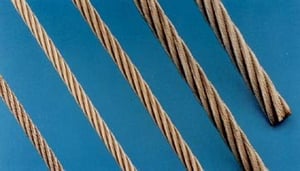From mining and construction to military and aerospace, aircraft cables and wire ropes are used all over the world to lift, pull, and steer heavy material. Though a wide range of cable configurations exist to make these functions possible, not every option may be suitable for your specific application. Before committing to a purchase, take the time to consider which core, construction, and material choices will create the safest and most efficient system.
Core
Our last blog discussed the differences between fiber core and IWRC wire ropes. In summary, fiber core ropes are more flexible than IWRC wire ropes, because the interior material is softer and more pliable. This reduces the rigidity of the core, allowing the entire rope to experience flexion. The downside to this increased flexibility is that it reduces the cable’s strength. Fiber core wire ropes usually offer less strength than an equivalent steel core, so you may want to consider an IWRC wire rope over a fiber core one if your application requires heavy lifting. If your application requires more flexibility but less strength, fiber core wire rope may be a better option. Before selecting a wire rope or cable, it is important to understand how and where it will be used so you know how to balance these features most effectively.

Construction
In general, the more wires a cable construction has, the more flexible it is compared to constructions with fewer wires. For example, a 7x19 cable with 133 wires is significantly more flexible than a 7x7 aircraft cable with only 49 wires. If your cable is slated to experience frequent bending, especially around pulleys and sheaves, we recommend employing highly flexible cable such as 7x19. If you intend to use your cable for push-pull applications that do not require bending, we recommend 7x7 moderately flexible aircraft cable, or non-flexible 1x7 or 1x19 strand.

Material
Both our general purpose wire rope and aircraft cable are available in stainless steel and galvanized steel. Each material has its own unique qualities, including strength benefits and corrosion resistance that make them durable enough to survive even the harshest working conditions. In general, stainless steel is more corrosive resistant than galvanized steel, but galvanized steel typically provides a higher breaking strength. If your cable will encounter salt water or high heat during operation, you may want to choose stainless steel, but for applications that do not require extra protection, galvanized steel is a great option.
Our wire rope craftsmen are always ready to answer any questions or inquiries you may have. Learn more information about our aircraft cable and general purpose wire rope by visiting the products page on our website, or contacting us.

